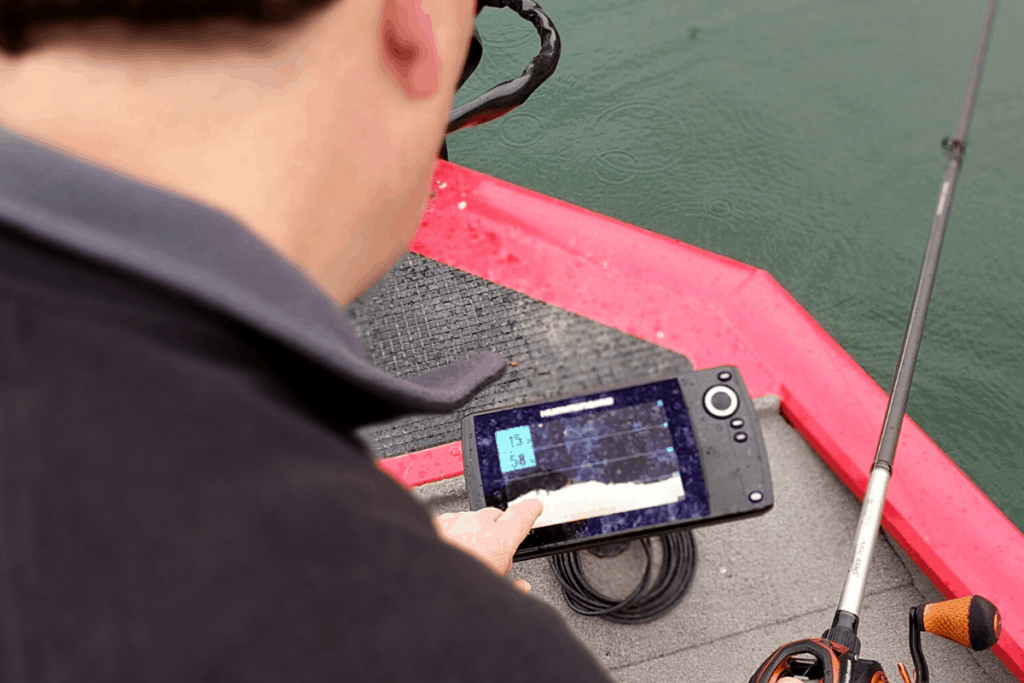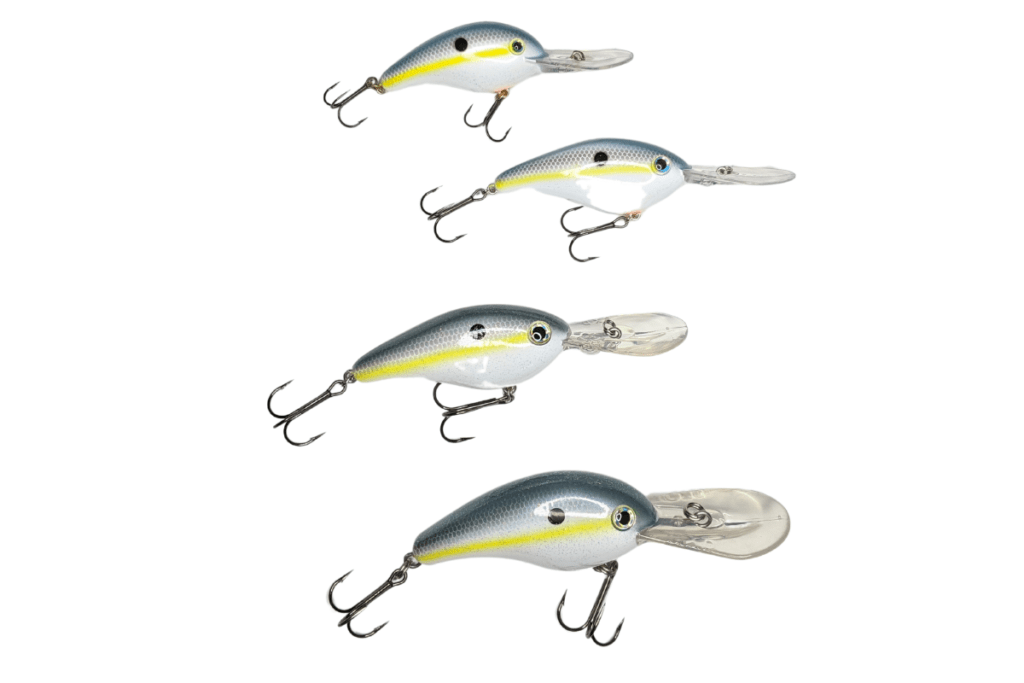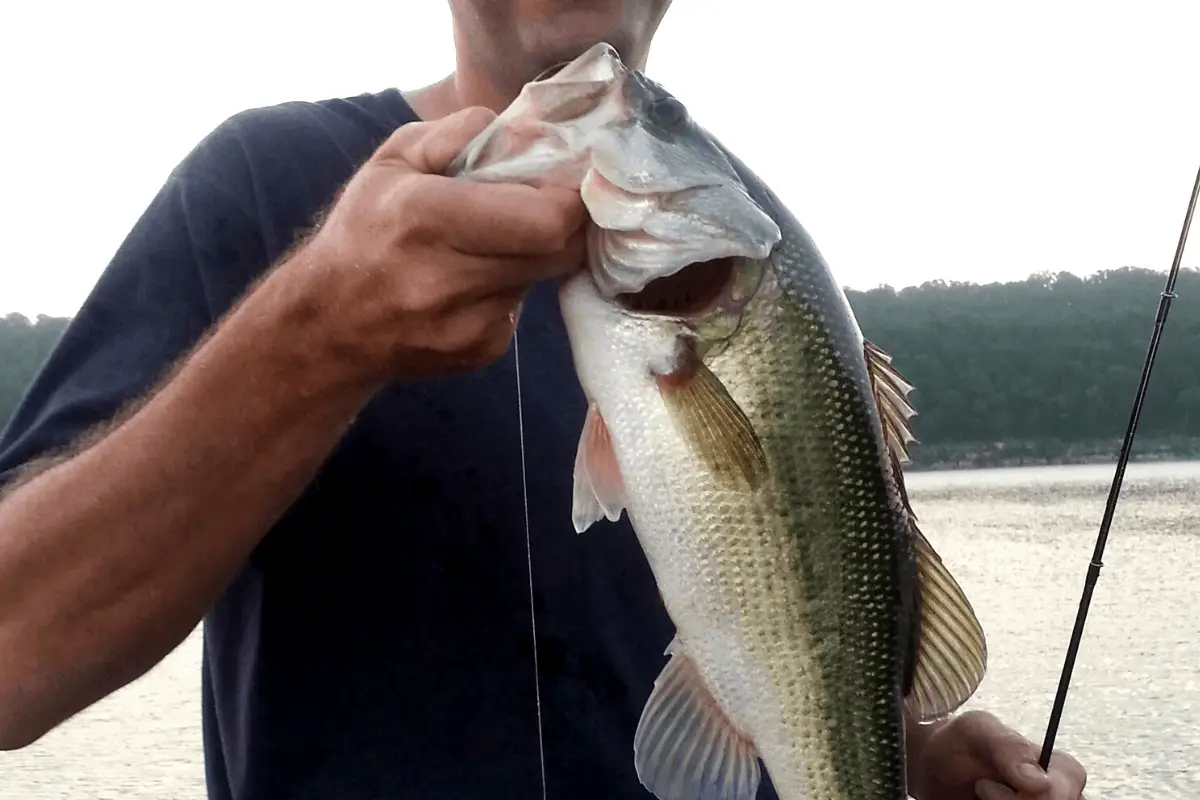All bass anglers spend time beating the bank – it’s fun. There are times when it is more productive to move offshore and pull some bass from schools of fish sitting in deep water. These 8 tips will get you well on your way to having offshore success.
Catching bass from deep water takes commitment. It also requires anglers to find deep water access and practice using their electronics. Finding high percentage areas and using the right lures to locate deep bass can launch your offshore confidence.
In this article, I will break down the 8 best tips that I feel will lead you to deep water success.
What Qualifies as Deep Water?
I remember an era when I never tossed a lure past the ten-foot mark. I focused on shallow bass and that is where I spent my time. When my depth finder (Here is an article on finding bass without a depth finder) read twenty feet I was lost.
Then I had the opportunity to fish with many deepwater anglers. It changed my approach forever.
For the sake of conversation, it is important to know that deep water is relative to the places you fish. For some of us, that may mean something around thirty feet. For others that is seventy feet, while some are in deep water at fifteen feet.
The concepts discussed here will work in every one of those deeper water scenarios, yet certain lures will be better than others. A deep-diving crankbait is not going to reach anything much past the twenty-five-foot mark.
1. Commitment
This is the first hurdle. It’s a big one.
It took more experienced anglers showing me how to catch deep water bass over twenty years ago for my mind to accept the fact that I could do it. I am so thankful for those mentors.
That is why I want to write this and help others conquer this mental block.
It literally takes one fish, caught deep, to change your entire mindset and open up a world of bass angling that many overlook.
My suggestion is to save this deep water fishing for times when the shallow bank-running is not producing the results you are looking for. This will provide you the mental fortitude to abandon the shallow stuff since it isn’t working and practice deeper water tactics.
The heat of summer is an excellent time to really dial this in. Many bass, especially the bigger ones, tend to move offshore and find deep water hangouts with their buddies.
2. Deep Water Access
Where to start. That always seems to be the question.
Let’s make it easy.
When attempting to locate deep water bass I find that investigating points is an area that yields a high rate of return.
When searching these points for schools of fish, I prefer to find the area of the point where it quickly drops off to deep water. This may be following the taper straight out into the lake and then suddenly it drops off, but more likely the point has one side to it that slopes to deep water at a considerably faster rate than the other.
This is a great place to start seeking out those hidden schools.
Keep in mind, you are always thinking deeper water – not deep water.
On one point this might be thirty feet. On another point, it could be twenty feet. It is all relative to the structure you are fishing at the moment.

3. Practice with Your Electronics
The quality of electronic graphs today is amazing but it does take some practice to build the confidence to locate fish with them.
Start in areas where you are sure of the bottom composition and graph them. Notice how hard bottom features return brighter and more defined than a softer or muddier structure.
Rig up a drop shot and lower it right by the puck on the trolling motor. Make sure that you can see the lure dropping down. Bounce it. Pull it up. Get used to how it looks.
Don’t be afraid to adjust the sensitivity, contrast, and other settings to get the best signal you are comfortable with. Every graph has a “default” button that will return it to factory settings if you feel things are getting too out of control.
Does your graph have Chirp? Does it use Down Imaging? Maybe you are even lucky enough to have something like Live Scope.
I find that I can pick fish off the bottom better with the Chirp display, but I have my electronics set on a split-screen between the two.
I fish lots of lakes with extreme vegetation and these read much differently than a lake or river that is solely a rock bottom.
If you have a friend that is confident with their electronics in deep water ask them to take you out and really dive into it. That’s what I did.
When you are moving along with your trolling motor, spot a blip on the screen that you are sure is a fish, drop down to and watch it come up and take the lure, it is a feeling you will never forget.
Practice. Practice. Practice.
It will pay off and change the way you approach the water.
4. Can you Find 45° Banks?
Fish love to hang on these types of banks. I have caught so many quality bass on this singular type of structure.
It allows bass to move from shallow to deep water quickly while maintaining their position to the lake bed.
The easiest place to find a 45° shoreline is to start at a point and follow it back into a cove, channel, or pocket. Usually, one side or the other will transition into this type of bank.
Another excellent place to locate them is where a bluff bank transitions to a more traditional shoreline. This will be on the ends of the bluffs and are magnets for schools of bass.
You may also find a good 45° bank in the middle of a long stretch of flat shoreline. If that is the case, you can bet that there are going to be some deeper water bass holding there so they can move up at will and then slide down to deep water when they want to.
Of course, topographical maps are great tools to locate this type of structure, but my first choice is Google Earth. You can scour a lake or river on the online tool and find small stretches of ideal areas that are not always easy to pull from a topo map.
Schools of bass may hang in a spot that is only the size of a car. It doesn’t take much of a difference to be an ideal location.
5. Start with a High Percentage Lure When Bass Fishing Deep Water
There are lots of great tools for probing the depths and locating that school of deep bass.
If you are just starting to investigate offshore fishing, I suggest using a lure and presentation that yields a lot of bites to build confidence.
A drop shot rig is how I did that so long ago.
This finesse presentation gets bit. A lot.
When trying to learn a new technique, especially locating and catching deep water bass, this may be the ideal rig to start with.
Fish of all sizes will chomp it. And remember, we are looking to catch some so we are confident in the process. The drop shot rig is also easy to see on the electronics and it keeps the lure suspended just off the bottom. This forces the fish to come up to it so anglers learning their graphs will actually see the line rise up off the bottom and come take the bait. So fun!
Once you start to become comfortable and get some bites on the drop shot, you can move to some other techniques – like a shaky head.
I also like to fish a big plastic worm on a Texas rig. It is easy to cover a lot of water with this technique and it draws bites from big bass.

6. Deep Diving Crankbaits
Deep diving crankbaits are a staple of offshore anglers and can get a school fired up in a hurry. Even to the point of catching fish on every cast.
The key to using these lures for deep water bass is throwing the crankbait way past your intended target so it has time to get to the proper depth before it runs through the ideal zone.
I find that maintaining contact with the bottom is also critical when offshore fishing with crankbaits.
A good selection of lures that run at various depths is important so you can dial it in and hit the area you are looking for. A deep diver is the fastest way to search for those fish and locate exactly where they are sitting, but it is not the easiest way to get a bite.
You have to trust the process. It is also best when targeting twenty-five feet of water or less.
I have spent time in the boat with Bassmaster Classic Champ and multiple Angler of the Year winner Mark Davis. He is a crankbait guru and uses deep divers to locate offshore schools on a regular basis.
While fishing with him one hot summer day, he spent several hours casting and hauling empty water before we finally found a big school sitting on the ledge of a creek channel. Then we proceeded to catch them nonstop for almost forty-five minutes.
A lot of hunting and searching, but it was worth it. Deep divers were the tool of choice to make that memorable outing happen.
7. Proper Equipment
Fishing deep requires different equipment than shallow water angling.
I like to use straight fluorocarbon because it sinks and is low-stretch. When there is a lot of line in the water the hookset can be much more difficult. It is shocking how much stretch there is in monofilament. I want as much energy as possible sent directly to the hook.
When deep water fishing with vertical presentations, rod length is important, but not as critical as when deep water fishing with a more horizontal presentation. A longer rod, over 7ft, can move much more line and pull up any slack faster than a rod under 7ft.
A longer rod will also allow an angler to throw a lure a very long distance. This is important when fishing deep diving crankbaits. A long cast, past the target, will allow the crankbait to get the proper depth before it reaches the target zone.
I also prefer to spend a little more money on my deep water rods, like the drop shot, because sensitivity plays a role when there is a lot of line in the water. The bite may be subtle and a rod made with less material, yet maintaining strength, will transfer those subtle bites to the angler much more efficiently than a more price-point rod.
8. Keep at it
I will never forget the first time I fished Table Rock Lake in the later summer. Those bass on that lake are notoriously hard to catch that time of year on the Rock because they go deep.
Twenty years ago I had no clue how to catch them.
I pulled up to a shoreline and beat the bank with a small crankbait. I was catching a few spotted bass and the occasional smallmouth, but they were all tiny.
I watched another angler pull up at the end of a long point. It looked like he was sitting out in the middle of no-man’s-land.
He proceeded to catch one nice bass after another. It was so frustrating I had to pull the trolling motor up and leave. I promised myself that I would figure it out someday.
It may not be as fun as pitching a jig to shallow, visible cover and wrestling a hog out from under a dock, but fishing deep can save the day when the shallow bite is not happening.
Like I mentioned at the beginning of this article – it only takes one.
That first deepwater fish will ignite a confidence that will lead to the next one. The next technique. The next outing where your target those offshore schools of bass and catch one-after-another.
Keep at it and you will soon be the angler that is catching them when others are struggling to find some shallow bass willing to play.
Final Thoughts
Following these 8 tips will launch your deep water bass fishing experience.
Commit to it. Spend some dedicated time learning and asking other anglers if they can show you some tips.
Find that deep-water access. Does a point drop off into the depths? Is there a creek channel ledge nearby?
Spend time with those electronics and commit to learning them. Don’t be afraid to investigate the different settings and sensitivity levels. When in doubt – hit the return to default button.
Are there 45° banks on your body of water? These are great places to find deep water bass.
Use high percentage lures, like a drop shot rig, to build that confidence. Then move to other baits and techniques as you feel comfortable.
Deep diving crankbaits are excellent tools to locate offshore fish. Practice with them and maintain bottom contact.
Have the proper line and equipment for pulling up these deep bass.
Keep at it. Dedicate time to it and soon you will be finding fish others are missing.
What have you found that works best for you when fishing deep? Comment below.
Be Safe. Tight lines, and remember to encourage someone today. You never know how you may change their life forever.
Isaiah 6:8

